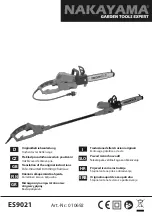
3
TRANSPORTING LITHIUM BATTERIES
Transport the battery pack in accordance with local and
national provisions and regulations.
Follow all special requirements on packaging and labelling
when transporting batteries by a third party. Ensure that
no batteries can come in contact with other batteries
or conductive materials while in transport by protecting
exposed connectors with insulating, non-conductive caps
or tape. Do not transport batteries that are cracked or
leaking. Check with the forwarding company for further
advice.
MAINTENANCE
WARNING
Remove the battery pack before assembling parts,
making adjustments, cleaning, performing maintenance,
or when the product is not in use. Removing the battery
pack prevents accidental starting that could cause
serious injury.
WARNING
Use only original manufacturer’s replacement parts,
accessories, and attachments. Failure to do so can cause
possible injury, can contribute to poor performance, and
may void your warranty.
■
Avoid using solvents when cleaning plastic parts. Most
plastics are susceptible to various types of commercial
solvents and may be damaged by their use. Use clean
cloths to remove dirt, carbon, dust, etc.
WARNING
Do not at any time let brake fluids, gasoline, petroleum-
based products, penetrating oils, etc., come in contact
with plastic parts. Chemicals can damage, weaken, or
destroy plastic, which may result in serious personal
injury.
WARNING
Servicing requires extreme care and knowledge
and should be performed only by a qualified service
technician. For service, bring the product to the nearest
authorised service centre for repair. When servicing, use
only original replacement parts.
WARNING
Use only approved pruning blades in the pruning saw.
The blades must be 6” or less in length and below 25 mm
in height. Any blade larger than this specification can
damage the pruning saw and may void your warranty.
RESIDUAL RISKS
Even when the product is used as prescribed, it is still
impossible to completely eliminate certain residual risk
factors. The following hazards may arise, and the operator
should pay special attention to avoid the following:
■
injury caused by vibration
–
Use the lowest speed setting that achieves the
cutting. Limit exposure. See “Risk reduction.”
■
injury caused by dust
–
Dust may enter the eyes or respiratory system.
Wear eye protection at all times. Wear the
appropriate dust-control mask with filters suitable
for protecting against particles from the material
being cut. Do not eat, drink, or smoke in the work
area. Ensure adequate ventilation.
■
injury caused by electric shock
–
The blade may contact hidden wiring, causing
parts of the product to become live. Always hold
the product by the designated handles, and take
care when blind-cutting into walls and floors where
cables may be hidden.
■
injury caused by contact with the blade
–
The blades are very sharp and will become hot
during use. Wear gloves when changing blades.
Keep hands away from the cutting area at all times.
Clamp the workpiece whenever possible.
■
injury caused by noise
–
Noise can damage hearing. When using power
tools for an extended period of time, wear hearing
protection.
RISK REDUCTION
It has been reported that vibrations from handheld tools
may contribute to a condition called Raynaud’s Syndrome.
Symptoms may include tingling, numbness, and blanching
of the fingers, usually apparent upon exposure to cold.
Hereditary factors, exposure to cold and dampness, diet,
smoking, and work practices are all thought to contribute to
the development of these symptoms. There are measures
that can be taken by the operator to possibly reduce the
effects of vibration:
■
Keep your body warm in cold weather. When operating
the product, wear gloves to keep the hands and wrists
warm. It is reported that cold weather is a major factor
contributing to Raynaud’s Syndrome.
■
After each period of operation, exercise to increase
blood circulation.
■
Take frequent work breaks. Limit the amount of
exposure per day.
If you experience any of the symptoms of this condition,
immediately discontinue use and see your physician.
WARNING
Injuries may be caused, or aggravated, by prolonged
use of a tool. When using any tool for prolonged periods,
ensure that you take regular breaks.
Summary of Contents for OPS18
Page 1: ...ORIGINAL INSTRUCTIONS Cordless Pruning Saw OPS18...
Page 7: ...5 WHAT S IN THE BOX x 1 x 1 x 1...
Page 17: ......
Page 18: ......
Page 19: ......






































